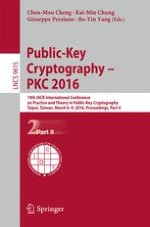2016 | OriginalPaper | Buchkapitel
Leakage-Resilient Public-Key Encryption from Obfuscation
verfasst von : Dana Dachman-Soled, S. Dov Gordon, Feng-Hao Liu, Adam O’Neill, Hong-Sheng Zhou
Erschienen in: Public-Key Cryptography – PKC 2016
Verlag: Springer Berlin Heidelberg
Aktivieren Sie unsere intelligente Suche, um passende Fachinhalte oder Patente zu finden.
Wählen Sie Textabschnitte aus um mit Künstlicher Intelligenz passenden Patente zu finden. powered by
Markieren Sie Textabschnitte, um KI-gestützt weitere passende Inhalte zu finden. powered by
